headrest NISSAN CUBE 2011 3.G Owners Manual
[x] Cancel search | Manufacturer: NISSAN, Model Year: 2011, Model line: CUBE, Model: NISSAN CUBE 2011 3.GPages: 345, PDF Size: 2.97 MB
Page 8 of 345

Black plate (4,1)
Model "Z12-D" EDITED: 2010/ 9/ 27
SSI0659
1. Supplemental front-impact air bags (Page 1-41)
2. Front seat-mounted side-impact supplemental airbags (P.1-41)
3. Seat belts (P.1-12)
4. Head restraints (P.1-6) — Front-seat Active Head Restraints (P.1-9)
5. Roof-mounted curtain side-impact supplemental air bags (P.1-41)
6. Rear headrests* (P.1-9)
7. Rear center seat belt* (P.1-18)
8. Occupant classification sensors (weight sensors) — Advanced Air Bag System (P.1-47)
9. Front seats (P.1-3)
10. Seat belt with pretensioners (P.1-53) 11. Rear seats* (P.1-4)
— Child restraints (P.1-23)
12. LATCH (Lower Anchors and Tethers for CHildren) system* (P.1-24)
*: except for Cargo Van modelsSEATS, SEAT BELTS AND
SUPPLEMENTAL RESTRAINT
SYSTEM (SRS)0-2
Illustrated table of contents
Page 19 of 345
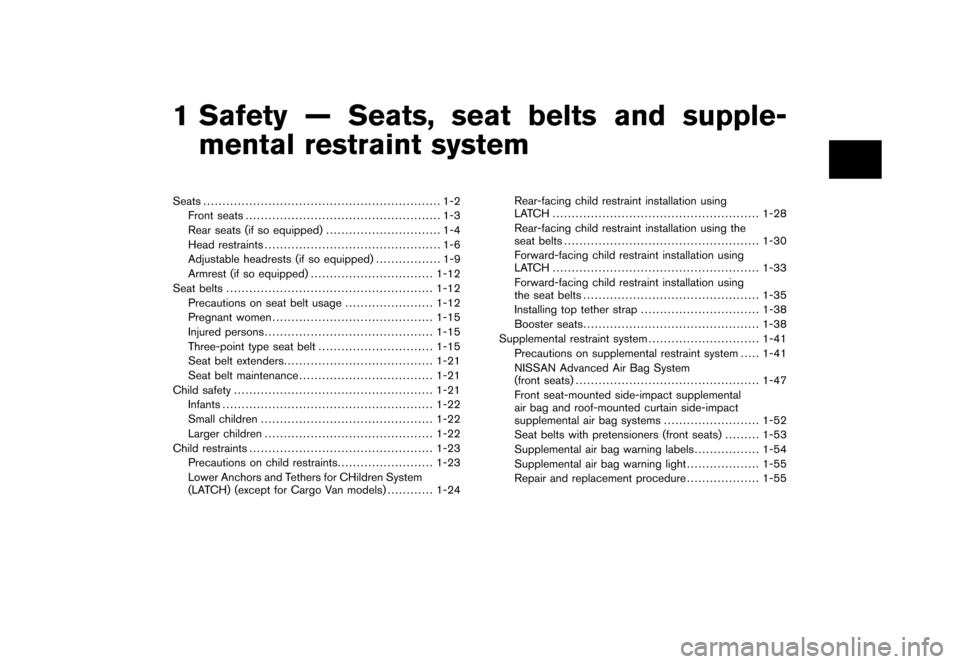
Black plate (4,1)
1 Safety — Seats, seat belts and supple-mental restraint system
Model "Z12-D" EDITED: 2010/ 9/ 27
Seats .............................................................. 1-2
Front seats ................................................... 1-3
Rear seats (if so equipped) .............................. 1-4
Head restraints .............................................. 1-6
Adjustable headrests (if so equipped) ................. 1-9
Armrest (if so equipped) ................................ 1-12
Seat belts ...................................................... 1-12
Precautions on seat belt usage ....................... 1-12
Pregnant women .......................................... 1-15
Injured persons ............................................ 1-15
Three-point type seat belt .............................. 1-15
Seat belt extenders ....................................... 1-21
Seat belt maintenance ................................... 1-21
Child safety .................................................... 1-21
Infants ....................................................... 1-22
Small children ............................................. 1-22
Larger children ............................................ 1-22
Child restraints ................................................ 1-23
Precautions on child restraints ......................... 1-23
Lower Anchors and Tethers for CHildren System
(LATCH) (except for Cargo Van models) ............ 1-24Rear-facing child restraint installation using
LATCH ...................................................... 1-28
Rear-facing child restraint installation using the
seat belts
................................................... 1-30
Forward-facing child restraint installation using
LATCH ...................................................... 1-33
Forward-facing child restraint installation using
the seat belts .............................................. 1-35
Installing top tether strap ............................... 1-38
Booster seats .............................................. 1-38
Supplemental restraint system ............................. 1-41
Precautions on supplemental restraint system . .... 1-41
NISSAN Advanced Air Bag System
(front seats) ................................................ 1-47
Front seat-mounted side-impact supplemental
air bag and roof-mounted curtain side-impact
supplemental air bag systems ......................... 1-52
Seat belts with pretensioners (front seats) ......... 1-53
Supplemental air bag warning labels ................. 1-54
Supplemental air bag warning light ................... 1-55
Repair and replacement procedure ................... 1-55
Page 27 of 345

Black plate (23,1)
Model "Z12-D" EDITED: 2010/ 9/ 27
SSS0508
Front-seat Active Head RestraintsThe Active Head Restraint moves forward
utilizing the force that the seatback receives
from the occupant in a rear-end collision. The
movement of the head restraint helps support
the occupant’s head by reducing its backward
movement and helping absorb some of the
forces that may lead to whiplash-type injuries.
Active Head Restraints are effective for colli-
sions at low to medium speeds in which it is said
that whiplash injury occurs most.
Active Head Restraints operate only in certain
rear-end collisions. After the collision, the head
restraints return to their original positions.Properly adjust the Active Head Restraints as
described in this section.
ADJUSTABLE HEADRESTS (if so
equipped)
WARNING
The adjustable headrests supplement
the other vehicle safety systems. They
may provide additional protection
against injury in certain rear end colli-
sions. Adjust the headrest properly, as
specifiedinthissection.Checkthe
adjustment after someone else uses
the seat. Do not attach anything to the
adjustable headrest stalks or remove
the adjustable headrest. Do not use the
seat if the adjustable headrest has
been removed. If the adjustable head-
rest was removed, reinstall and prop-
erly adjust the headrest before an
occupant uses the seating position.
Failure to follow these instructions
can reduce the effectiveness of the
adjustable headrests. This may in-
creasetheriskofseriousinjuryor
death in a collision.
SSS1048
The illustration shows the seating positions
equipped with adjustable headrests.
Indicates the seating position is equipped
with an adjustable headrest.
Safety — Seats, seat belts and supplemental restraint system
1-9
Page 28 of 345
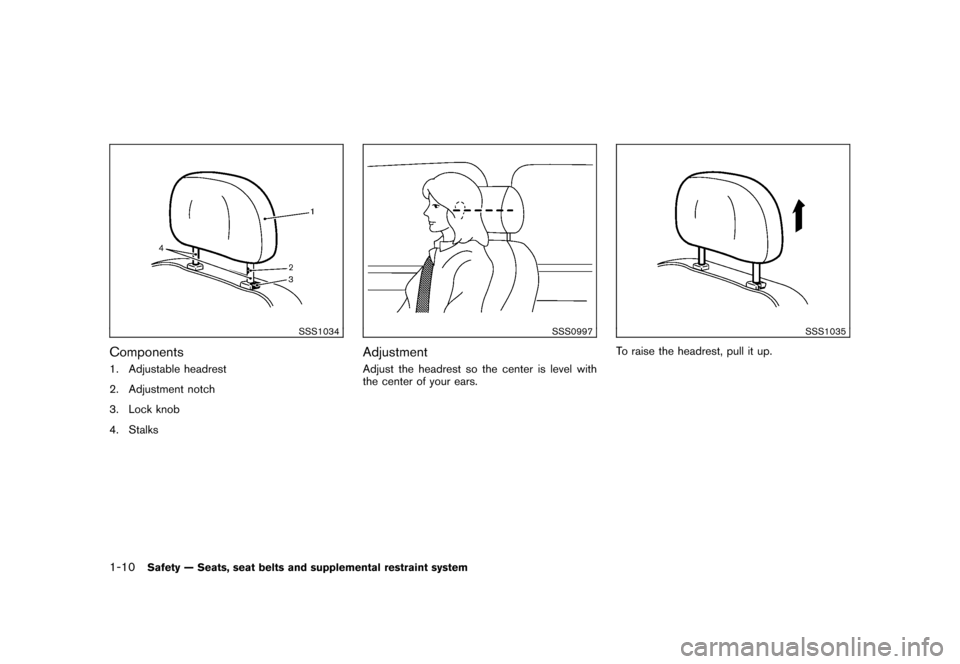
Black plate (24,1)
Model "Z12-D" EDITED: 2010/ 9/ 27
SSS1034
Components1. Adjustable headrest
2. Adjustment notch
3. Lock knob
4. Stalks
SSS0997
AdjustmentAdjust the headrest so the center is level with
the center of your ears.
SSS1035
To raise the headrest, pull it up.
1-10
Safety — Seats, seat belts and supplemental restraint system
Page 29 of 345

Black plate (25,1)
Model "Z12-D" EDITED: 2010/ 9/ 27
SSS1036
To lower, push and hold the lock knob and push
the headrest down.
SSS1037
RemovalUse the following procedure to remove the
adjustable headrests.
1. Pull the headrest up to the highest position.
2. Push and hold the lock knob.
3. Remove the headrest from the seat.
4. Store the headrest properly in a secureplace so it is not loose in the vehicle.
5. Reinstall and properly adjust the headrest before an occupant uses the seating posi-
tion.
SSS1038
Install1. Align the headrest stalks with the holes inthe seat. Make sure that the headrest is
facing the correct direction. The stalk with
the adjustment notch
*1
must be installed
in the hole with the lock knob
*2.
2. Push and hold the lock knob and push the headrest down.
3. Properly adjust the headrest before an occupant uses the seating position.
Safety — Seats, seat belts and supplemental restraint system
1-11
Page 45 of 345
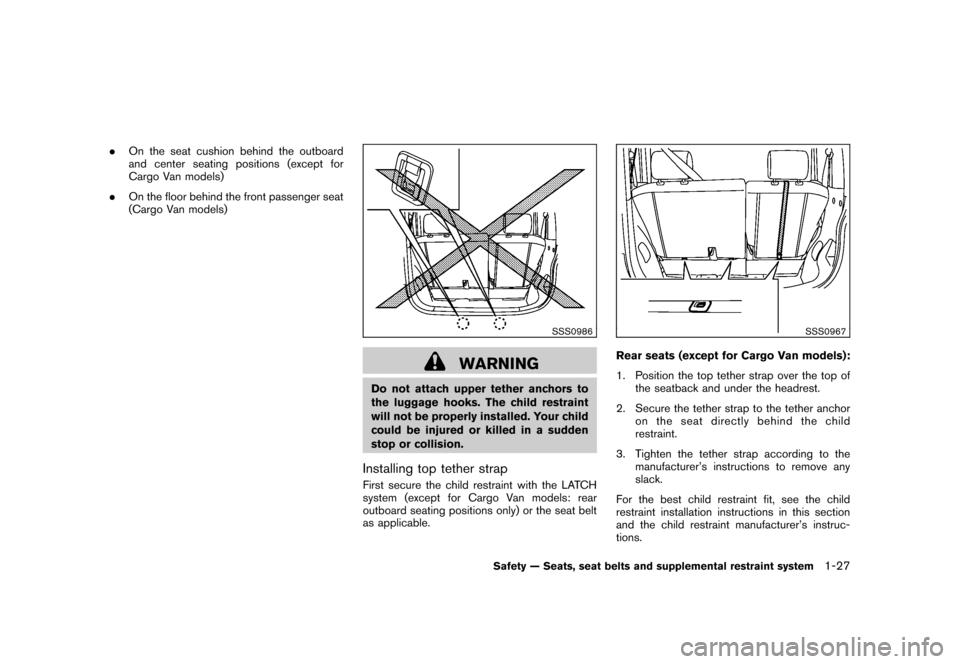
Black plate (41,1)
Model "Z12-D" EDITED: 2010/ 9/ 27
.On the seat cushion behind the outboard
and center seating positions (except for
Cargo Van models)
. On the floor behind the front passenger seat
(Cargo Van models)
SSS0986
WARNING
Do not attach upper tether anchors to
the luggage hooks. The child restraint
will not be properly installed. Your child
could be injured or killed in a sudden
stop or collision.Installing top tether strapFirst secure the child restraint with the LATCH
system (except for Cargo Van models: rear
outboard seating positions only) or the seat belt
as applicable.
SSS0967
Rear seats (except for Cargo Van models):
1. Position the top tether strap over the top of
the seatback and under the headrest.
2. Secure the tether strap to the tether anchor on the seat directly behind the child
restraint.
3. Tighten the tether strap according to the manufacturer’s instructions to remove any
slack.
For the best child restraint fit, see the child
restraint installation instructions in this section
and the child restraint manufacturer’s instruc-
tions.
Safety — Seats, seat belts and supplemental restraint system
1-27
Page 52 of 345
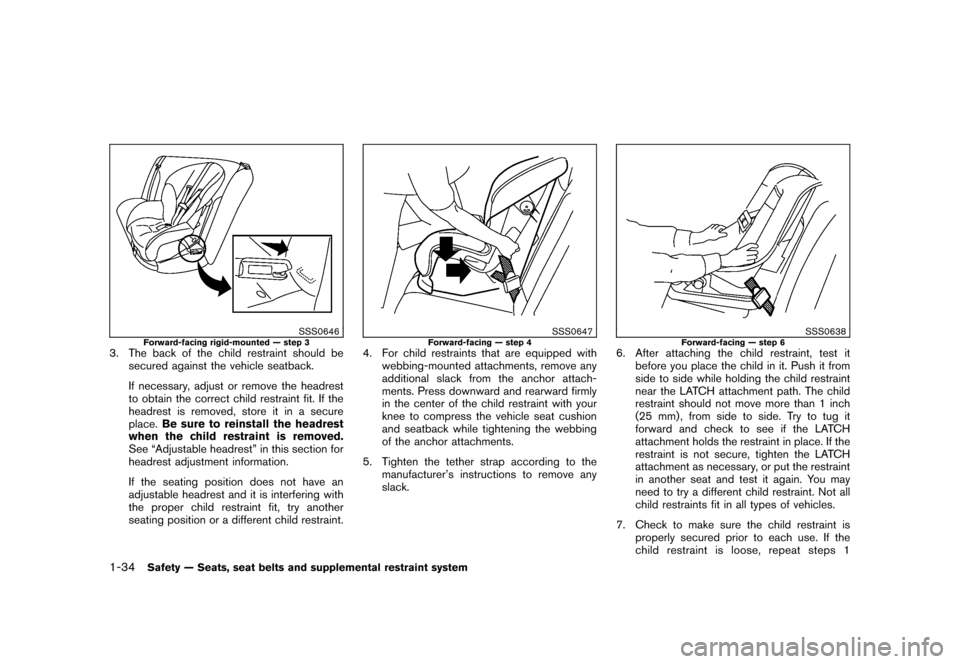
Black plate (48,1)
Model "Z12-D" EDITED: 2010/ 9/ 27
SSS0646
Forward-facing rigid-mounted — step 3
3. The back of the child restraint should besecured against the vehicle seatback.
If necessary, adjust or remove the headrest
to obtain the correct child restraint fit. If the
headrest is removed, store it in a secure
place. Be sure to reinstall the headrest
when the child restraint is removed.
See “Adjustable headrest” in this section for
headrest adjustment information.
If the seating position does not have an
adjustable headrest and it is interfering with
the proper child restraint fit, try another
seating position or a different child restraint.
SSS0647
Forward-facing — step 4
4. For child restraints that are equipped with webbing-mounted attachments, remove any
additional slack from the anchor attach-
ments. Press downward and rearward firmly
in the center of the child restraint with your
knee to compress the vehicle seat cushion
and seatback while tightening the webbing
of the anchor attachments.
5. Tighten the tether strap according to the manufacturer’s instructions to remove any
slack.
SSS0638
Forward-facing — step 6
6. After attaching the child restraint, test itbefore you place the child in it. Push it from
side to side while holding the child restraint
near the LATCH attachment path. The child
restraint should not move more than 1 inch
(25 mm) , from side to side. Try to tug it
forward and check to see if the LATCH
attachment holds the restraint in place. If the
restraint is not secure, tighten the LATCH
attachment as necessary, or put the restraint
in another seat and test it again. You may
need to try a different child restraint. Not all
child restraints fit in all types of vehicles.
7. Check to make sure the child restraint is properly secured prior to each use. If the
child restraint is loose, repeat steps 1
1-34
Safety — Seats, seat belts and supplemental restraint system
Page 53 of 345
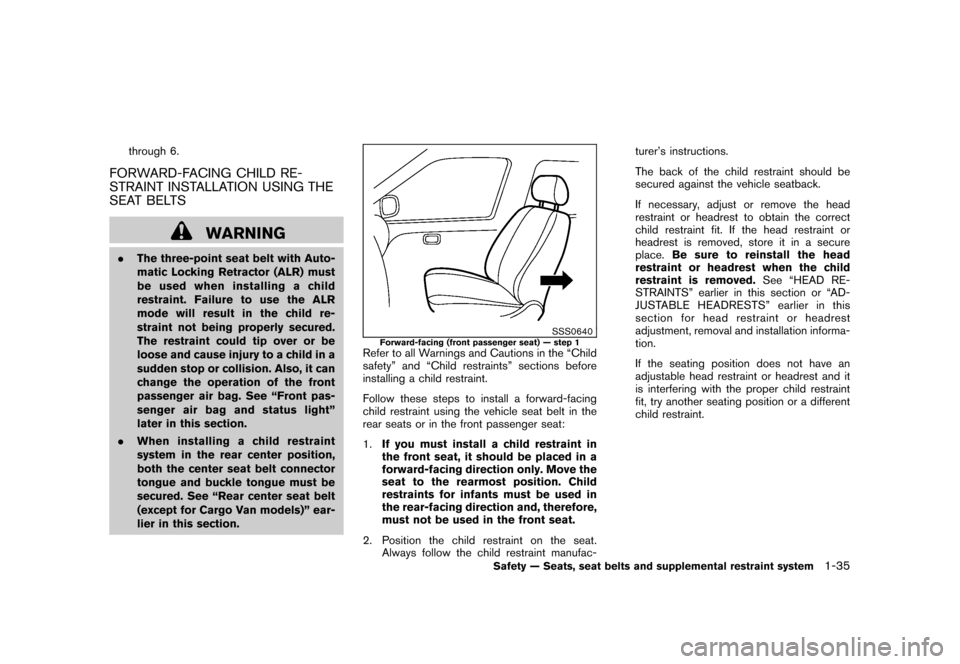
Black plate (49,1)
Model "Z12-D" EDITED: 2010/ 9/ 27
through 6.
FORWARD-FACING CHILD RE-
STRAINT INSTALLATION USING THE
SEAT BELTS
WARNING
.The three-point seat belt with Auto-
matic Locking Retractor (ALR) must
be used when installing a child
restraint. Failure to use the ALR
mode will result in the child re-
straint not being properly secured.
The restraint could tip over or be
loose and cause injury to a child in a
sudden stop or collision. Also, it can
change the operation of the front
passenger air bag. See “Front pas-
senger air bag and status light”
later in this section.
. When installing a child restraint
system in the rear center position,
both the center seat belt connector
tongue and buckle tongue must be
secured. See “Rear center seat belt
(except for Cargo Van models)” ear-
lier in this section.
SSS0640
Forward-facing (front passenger seat) — step 1
Refer to all Warnings and Cautions in the “Child
safety” and “Child restraints” sections before
installing a child restraint.
Follow these steps to install a forward-facing
child restraint using the vehicle seat belt in the
rear seats or in the front passenger seat:
1.If you must install a child restraint in
the front seat, it should be placed in a
forward-facing direction only. Move the
seat to the rearmost position. Child
restraints for infants must be used in
the rear-facing direction and, therefore,
must not be used in the front seat.
2. Position the child restraint on the seat. Always follow the child restraint manufac- turer’s instructions.
The back of the child restraint should be
secured against the vehicle seatback.
If necessary, adjust or remove the head
restraint or headrest to obtain the correct
child restraint fit. If the head restraint or
headrest is removed, store it in a secure
place.
Be sure to reinstall the head
restraint or headrest when the child
restraint is removed. See “HEAD RE-
STRAINTS” earlier in this section or “AD-
JUSTABLE HEADRESTS” earlier in this
section for head restraint or headrest
adjustment, removal and installation informa-
tion.
If the seating position does not have an
adjustable head restraint or headrest and it
is interfering with the proper child restraint
fit, try another seating position or a different
child restraint.
Safety — Seats, seat belts and supplemental restraint system
1-35
Page 58 of 345
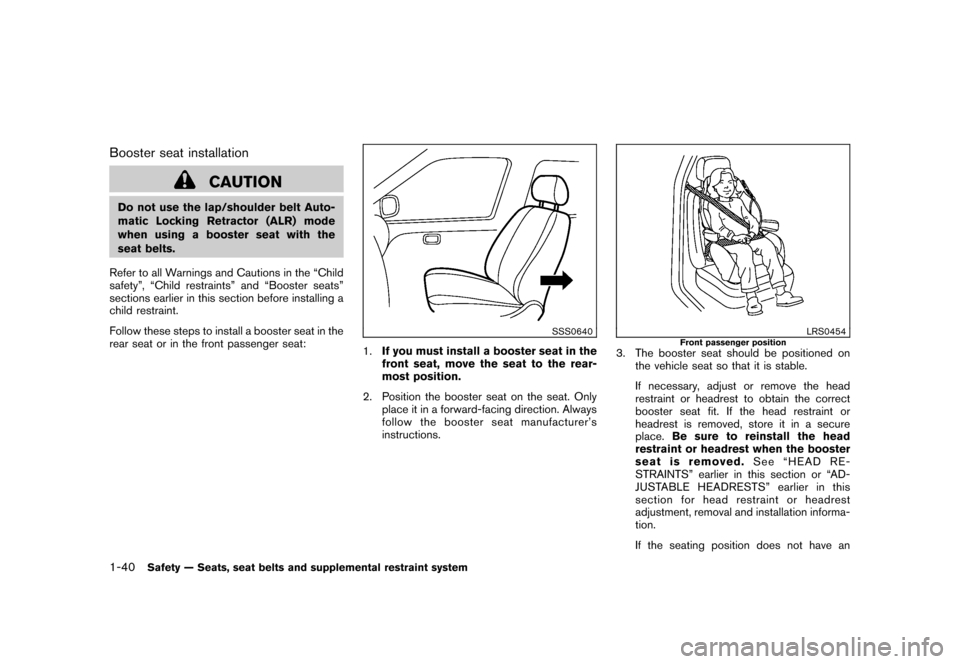
Black plate (54,1)
Model "Z12-D" EDITED: 2010/ 9/ 27
Booster seat installation
CAUTION
Do not use the lap/shoulder belt Auto-
matic Locking Retractor (ALR) mode
when using a booster seat with the
seat belts.
Refer to all Warnings and Cautions in the “Child
safety”, “Child restraints” and “Booster seats”
sections earlier in this section before installing a
child restraint.
Follow these steps to install a booster seat in the
rear seat or in the front passenger seat:
SSS0640
1. If you must install a booster seat in the
front seat, move the seat to the rear-
most position.
2. Position the booster seat on the seat. Only place it in a forward-facing direction. Always
follow the booster seat manufacturer’s
instructions.
LRS0454
Front passenger position
3. The booster seat should be positioned onthe vehicle seat so that it is stable.
If necessary, adjust or remove the head
restraint or headrest to obtain the correct
booster seat fit. If the head restraint or
headrest is removed, store it in a secure
place. Be sure to reinstall the head
restraint or headrest when the booster
seat is removed. See “HEAD RE-
STRAINTS” earlier in this section or “AD-
JUSTABLE HEADRESTS” earlier in this
section for head restraint or headrest
adjustment, removal and installation informa-
tion.
If the seating position does not have an
1-40
Safety — Seats, seat belts and supplemental restraint system
Page 59 of 345
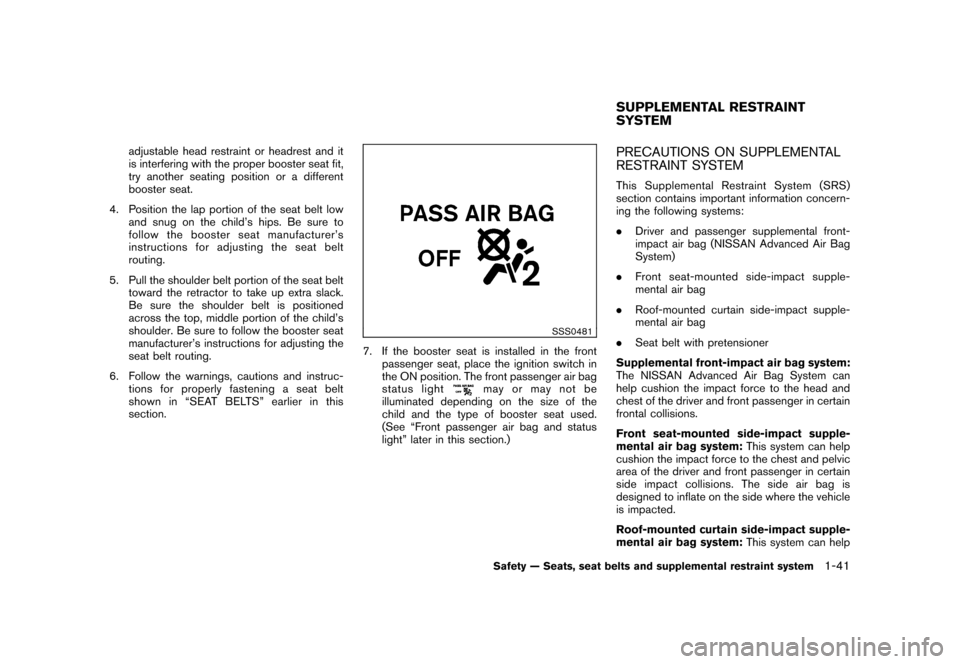
Black plate (55,1)
Model "Z12-D" EDITED: 2010/ 9/ 27
adjustable head restraint or headrest and it
is interfering with the proper booster seat fit,
try another seating position or a different
booster seat.
4. Position the lap portion of the seat belt low and snug on the child’s hips. Be sure to
follow the booster seat manufacturer’s
instructions for adjusting the seat belt
routing.
5. Pull the shoulder belt portion of the seat belt toward the retractor to take up extra slack.
Be sure the shoulder belt is positioned
across the top, middle portion of the child’s
shoulder. Be sure to follow the booster seat
manufacturer’s instructions for adjusting the
seat belt routing.
6. Follow the warnings, cautions and instruc- tions for properly fastening a seat belt
shownin“SEATBELTS”earlierinthis
section.
SSS0481
7. If the booster seat is installed in the frontpassenger seat, place the ignition switch in
the ON position. The front passenger air bag
status light
may or may not be
illuminated depending on the size of the
child and the type of booster seat used.
(See “Front passenger air bag and status
light” later in this section.)
PRECAUTIONS ON SUPPLEMENTAL
RESTRAINT SYSTEMThis Supplemental Restraint System (SRS)
section contains important information concern-
ing the following systems:
. Driver and passenger supplemental front-
impact air bag (NISSAN Advanced Air Bag
System)
. Front seat-mounted side-impact supple-
mental air bag
. Roof-mounted curtain side-impact supple-
mental air bag
. Seat belt with pretensioner
Supplemental front-impact air bag system:
The NISSAN Advanced Air Bag System can
help cushion the impact force to the head and
chest of the driver and front passenger in certain
frontal collisions.
Front seat-mounted side-impact supple-
mental air bag system: This system can help
cushion the impact force to the chest and pelvic
area of the driver and front passenger in certain
side impact collisions. The side air bag is
designed to inflate on the side where the vehicle
is impacted.
Roof-mounted curtain side-impact supple-
mental air bag system: This system can helpSUPPLEMENTAL RESTRAINT
SYSTEM
Safety — Seats, seat belts and supplemental restraint system
1-41